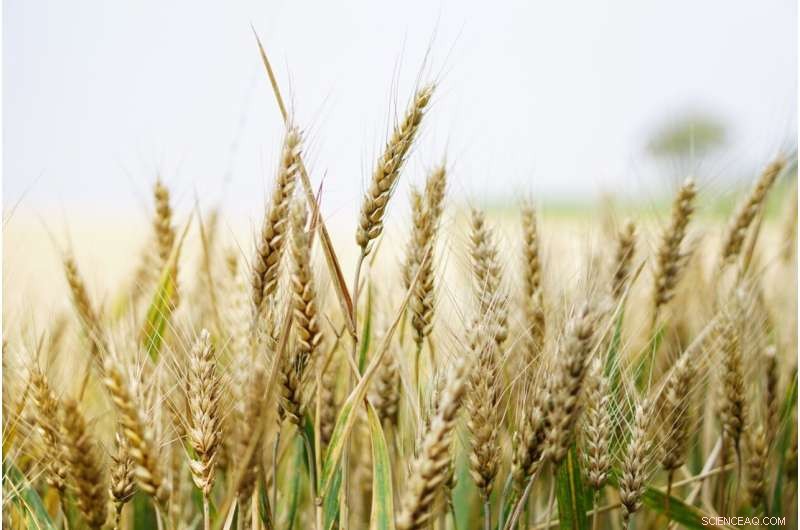
Wetenschap
Hoe snelgroeiende algen de groei van voedselgewassen kunnen verbeteren

Nieuw onderzoek identificeert manieren om de gewasopbrengst te verhogen door strategieën van een snelgroeiende algensoort op te nemen in planten zoals tarwe en rijst. Krediet:Pixabay
Een nieuwe studie biedt een kader om de groei van gewassen te stimuleren door een strategie op te nemen die is overgenomen van een snelgroeiende soort groene algen. De algen, bekend als Chlamydomonas reinhardtii, bevatten een organel, de pyrenoïde genaamd, die de omzetting van koolstof, die de algen uit de lucht opnemen, versnelt in een vorm die de organismen kunnen gebruiken voor groei. In een studie gepubliceerd op 19 mei 2022 in het tijdschrift Nature Plants , gebruikten onderzoekers van Princeton University en Northwestern University moleculaire modellering om de kenmerken van de pyrenoïde te identificeren die het meest cruciaal zijn voor het verbeteren van koolstoffixatie, en brachten vervolgens in kaart hoe deze functionaliteit in gewasplanten kon worden ingebouwd.
Dit is niet alleen een academische oefening. Voor veel mensen is het grootste deel van de voedselcalorieën afkomstig van gewassen die duizenden jaren geleden zijn gedomesticeerd. Sindsdien hebben vorderingen op het gebied van irrigatie, bemesting, fokken en de industrialisatie van de landbouw bijgedragen aan het voeden van de snelgroeiende menselijke bevolking. Op dit moment kan echter alleen nog maar incrementele winst uit deze technologieën worden gehaald. Ondertussen wordt voorspeld dat de voedselonzekerheid, die voor een groot deel van de wereldbevolking al op een crisisniveau is, zal verergeren als gevolg van een veranderend klimaat.
Nieuwe technologie zou deze trend kunnen keren. Veel wetenschappers geloven dat de algenpyrenoïde precies zo'n innovatie biedt. Als wetenschappers een pyrenoïde-achtig vermogen kunnen ontwikkelen om koolstof in planten zoals tarwe en rijst te concentreren, kunnen deze belangrijke voedselbronnen hun groeisnelheid aanzienlijk verhogen.
"Dit werk biedt duidelijke richtlijnen voor het construeren van een koolstofconcentratiemechanisme in planten, inclusief belangrijke gewassen", zegt Martin Jonikas, een senior auteur van de studie die universitair hoofddocent moleculaire biologie is aan Princeton en een onderzoeker aan het Howard Hughes Medical Institute. .
Chlamydomonas reinhardtii bereikt koolstoffixatie dankzij de werking van het enzym Rubisco, dat de omzetting van CO2 katalyseert into organic carbon.
Terrestrial plants also use Rubisco to accomplish carbon fixation, but in most plants, Rubisco only works at about a third of its theoretical capacity because it cannot access enough CO2 to operate faster. Much effort has therefore gone into studying the carbon-concentrating mechanisms, particularly those found in cyanobacteria and in Chlamydomonas, with the hope of eventually providing this function for terrestrial crop plants. But there's a problem:
"While the structure of the pyrenoid and many of its components are known, key biophysical questions about its mechanism remain unanswered, due to a lack of quantitative and systematic analysis," said senior co-author Ned Wingreen, Princeton's Howard A. Prior Professor of the Life Sciences and professor of molecular biology and the Lewis-Sigler Institute of Integrative Genomics.
To gain insights about how the algal pyrenoid carbon-concentrating mechanism works, Princeton graduate student Chenyi Fei collaborated with undergraduate Alexandra Wilson, Class of 2020, to develop a computational model of the pyrenoid with the help of co-author Niall Mangan, assistant professor of engineering sciences and applied mathematics at Northwestern University.
Prior work has shown that the Chlamydomonas reinhardtii pyrenoid consists of a spherical Rubisco matrix traversed by a vasculature of membrane-enclosed projections called pyrenoid tubules, and surrounded by a sheath made of starch. It's thought that CO2 taken up from the environment is converted into bicarbonate and then transported into the tubules, where it then enters the pyrenoid. An enzyme present in the tubules converts bicarbonate back into CO2 , which then diffuses into the Rubisco matrix. But is this picture complete?
"Our model demonstrates that this conventional picture of the pyrenoid carbon-concentrating mechanism can't work because CO2 would just rapidly leak back out of the pyrenoid before Rubisco could act on it," Wingreen said. "Instead, the starch shell around the pyrenoid must act as a diffusion barrier to trap CO2 in the pyrenoid with Rubisco."
In addition identifying this diffusion barrier, the researchers' model pinpointed other proteins and structural features needed for CO2 concentration. The model also identified non-necessary components, which should make engineering pyrenoid functionality into plants a simpler task. This simplified model of the pyrenoid, the researchers showed, behaves similarly to the actual organelle.
"The new model developed by Fei, Wilson, and colleagues is a game changer," said Alistair McCormick, an expert in Plant Molecular Physiology and Synthetic Biology at the University of Edinburgh, who has worked with the Princeton scientists but was not involved in this study.
"One of the key findings of this paper, which differentiates the Chlamydomonas carbon-concentrating mechanism from those found in cyanobacteria, is that introducing active bicarbonate transporters may not be necessary," McCormick said. "This is important because active bicarbonate transport has been a key challenge hindering progress in the engineering of biophysical carbon-concentrating mechanisms."
 Welke factoren hebben invloed op het smeltpunt?
Welke factoren hebben invloed op het smeltpunt?  Gefunctionaliseerde oppervlakken:cilindrische micellaire borstels met op maat gemaakte chemische opties met gecontroleerde lengte
Gefunctionaliseerde oppervlakken:cilindrische micellaire borstels met op maat gemaakte chemische opties met gecontroleerde lengte Wetenschappers hebben ontdekt hoe bloedwormen hun unieke koperen tanden maken
Wetenschappers hebben ontdekt hoe bloedwormen hun unieke koperen tanden maken Onderzoekers tonen aan dat een kankerverdedigingsmechanisme kan worden teruggedraaid om tumoren aan te vallen
Onderzoekers tonen aan dat een kankerverdedigingsmechanisme kan worden teruggedraaid om tumoren aan te vallen Waarom wordt steenzout ijs kouder?
Waarom wordt steenzout ijs kouder?
Hoofdlijnen
- Wat hebben spam-e-mail en hiv met elkaar gemeen?
- Hoe snel is een knipoog?
- Tribunelichten van 9/11 kunnen gevaarlijk zijn voor vogels studie zegt:
- Japanse walvisjagers naar Antarctica
- Law of Independent Assortment (Mendel): definitie, verklaring, voorbeeld
- Het verschil tussen craniologie en frenologie
- Een 3D-model van een plantencel bouwen
- Vliegen ontwikkelen springen zonder poten
- Whodunnit, als Aussie-reptielen uitsterven:studie (update)
 Hoe het verhogen van de belasting voor mensen met een hoog inkomen de ongelijkheid zou verminderen, het sociale welzijn in Nieuw-Zeeland verbeteren
Hoe het verhogen van de belasting voor mensen met een hoog inkomen de ongelijkheid zou verminderen, het sociale welzijn in Nieuw-Zeeland verbeteren Rolls-Royce verkoopt commerciële maritieme eenheid
Rolls-Royce verkoopt commerciële maritieme eenheid Onze koolstofbudgetten verstandig besteden
Onze koolstofbudgetten verstandig besteden Het verkennen en beëindigen van banen in Australië voor politieke economieën van partners
Het verkennen en beëindigen van banen in Australië voor politieke economieën van partners Onderzoekers gebruiken de S-matrix bootstrap om te onderzoeken of snaartheorie de enige consistente theorie van kwantumzwaartekracht is
Onderzoekers gebruiken de S-matrix bootstrap om te onderzoeken of snaartheorie de enige consistente theorie van kwantumzwaartekracht is Wetenschappers die kernspin bestuderen doen een verrassende ontdekking
Wetenschappers die kernspin bestuderen doen een verrassende ontdekking Verminderde luchtvochtigheid verhoogt de dreiging van natuurbranden in het zuidwesten van de Verenigde Staten
Verminderde luchtvochtigheid verhoogt de dreiging van natuurbranden in het zuidwesten van de Verenigde Staten Draagbare technologie biedt boost voor nucleaire veiligheid, wapenbeheersing
Draagbare technologie biedt boost voor nucleaire veiligheid, wapenbeheersing
- Elektronica
- Biologie
- Zonsverduistering
- Wiskunde
- French | Italian | Spanish | Portuguese | Swedish | German | Dutch | Danish | Norway |

-
Wetenschap © https://nl.scienceaq.com






